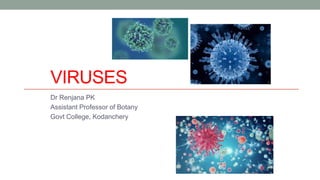
Viruses
- 1. VIRUSES Dr Renjana PK Assistant Professor of Botany Govt College, Kodanchery
- 2. Dmitri Iosifovich Ivanovsky was a Russian botanist, the discoverer of viruses (1892) and one of the founders of virology. Martinus Beijerinck called the filtered, infectious substance a "virus" and this discovery is considered to be the beginning of virology.
- 3. WHAT ARE VIRUSES ? The viruses are non-cellular, self-replicating, obligate, intracellular parasitic agents essen- tially composed of a protein that covers a central nucleic acid molecule, either RNA or DNA.
- 4. All known viruses are the pathogen of either plants or animals. They can exist outside the host cell for long period, but remain inert in free state.Size range from 18-400 nm Parvo virus– 18-26 nm Small pox virus – 400 nm Within the host cell, the virus grow, multiply and undergo mutation, but does not respire, rather depend completely on the enzyme system of the host cell for their activity.
- 5. Virus - venom (Poisonous fluid) • Simplest forms of life • Smaller than bacteria, simple organization • They are non-cellular, self-replicating agents • Grow and multiply intra-cellularly as an obligate parasite (i.e., grow only in living host) or remain inert outside the host. • The viruses consist of two parts: the centrally placed nucleic acid, covered by protein coat. • Depending on the symmetry, they are of three types: cubical, helical and complex.
- 6. • The nucleic acid is either DNA or RNA, but both do not remain together. • The nucleic acid may be single or double stranded. • The outer covering (capsid) is made up of protein units, called capsomeres • They have no machinery of their own for protein synthesis and thereby they use host machinery for the synthesis of protein • During replication, their nucleic acid directs the host cell to make different parts of virus and when these parts assemble together they form a complete infectious particle, the virion
- 8. LIVING • Can replicate inside a host cell • Can mutate • They have genetic material, or they possess genes (genome) • Attack specific host • Sensitive to stimulants NON LIVING • Non-cellular • Cannot reproduce by themselves • Do not grow • Do not possess ribosome, mitochondria etc. • Cannot respire • Remain inert in free state, can be crystallised
- 9. Structure – Nucleoprotein particles • The virus consists of two parts: • (i) Nucleic acid (centrally placed)- Contains one molecule of nucleic acid (Genome). • Either DNA (Deoxyviruses) or RNA (Riboviruses)- Single stranded or Double stranded • (ii) Protein coat (Capsid made of capsomeres), sometimes with additional envelope. • (iii) Lipoprotein envelope- animal viruses
- 10. Symmetry • Cubical – Shape of a polyhedron. (Tetrahedron, Hexahedron, Icosahedron) - Poliomyelitis virus, Papilloma virus, Adenoviruses • Helical -Both nucleic acid and capsomeres are coiled together and form a spiral or helical tube- Tobacco mosaic virus (TMV), Influenza virus, etc. • Complex- Viruses which do not conform to either of the above two types due to complexity of their structure -pox virus and bacteriophages like T2, T4, and T6
- 15. Classification Type of nucleic acid No. of strands in NA Envelope ICTV (International Committee on Taxonomy of Viruses) DNA Viruses Viruses RNA Viruses SS DS DS SS Enveloped Non Enveloped Enveloped Enveloped Enveloped Non Enveloped Non Enveloped Non Enveloped
- 16. Structure of viruses Viral genome Linear/Circular SS/DS DNA/RNA In some consists of segments Size varies Code for only few proteins Viral capsid Protein coat Highly variable Units- capsomeres Functions- Protection, adsorb to cell surface, determines antigenic properties Cubical/helical VIRION – Complete and infectious viral particle - Nucleocapsid
- 17. Viral envelope Additional envelope around the capsid Some animal viruses Lipoprotein composition Sometimes carbohydrates Partly from the host & partly from the virus Projecting spikes Chemical, biological & antigenic properties
- 18. Self replication/Duplication Governed by genetic information in genome Depend on synthetic machinery of host cell VIRAL MULTIPLICATION
- 24. Bacteriophages Viruses that parasitizes bacteria Twort & De Herelle T4 bacteriophage that parasitizes E. coli Double stranded DNA phage Head, neck, tail, base plate, tail fibres
- 25. 95X65 nm 80X18 nm 144 protein units, 24 rings 130 X2 nm
- 27. Multiplication of bacteriophage VIRULENT PHAGES TEMPERATE PHAGES
- 28. Lytic cycle
- 29. Lysogenic cycle
- 30. Lysogenic cycle
- 31. LYTIC CYCLE • Adsorption • Injection/entry • Protein synthesis • Genome synthesis • Maturation • Release – Lysis of the host bacterial cell LYSOGENIC CYCLE • Symbiotic association • Integrated into the bacterial chromosome- prophage • Replicates along with the host bacterium • Induction
- 33. TMV Tobacco Mosaic Virus Rod shaped helical RNA virus Causative agent of leaf mosaic disease 300 nm long & 15-18 nm diameter SS helical RNA core encased by 2130 capsomeres Each 3 turn of RNA helix- 49 nucleotides
